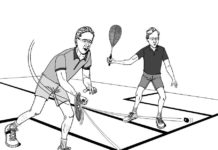
HEY REF! I’ve noticed that in so many cases, there is no
audible appeal when a player is asking for a let. I thought the rules required us to actually say “Let”. If not, do referees have to just guess?
This question will help us explain the more precise use of terminology adopted with the 2014 rules. The word ‘appeal’ is now used solely to refer to queries about a marker issue or a broken ball—whereas the term ‘request a let’ is used to refer to an issue relating to interference, distraction, or a fallen object.
The verbalization of a request for a let is the recommended method, both because it’s clear and it identifies the intended moment of the stoppage of play. However, the rules have always allowed the referee to accept other forms of appeal (a posturing, a raised hand, even, you know, the ‘look’). The only caution is that when you’re the ref, just be sure that the player really is asking for a let. It can be pretty embarrassing to award a let, or worse, a stroke—and then be told by the player himself/herself that in fact, the point was being conceded. Oops.
HEY REF! I heard that there are a few different things about the serve with the arrival of the new 2014 rules.
Well, there’s nothing earth shattering—just stuff to add clarity and eliminate questionable areas.
The first point is that it has been made clear that the onus is now on the server to make sure that the receiver is ready before serving. The idea is to avoid those frustrating re-serves. Of course, the ref can intervene if the receiver is suspected of artificially delaying the game.
The next item clarified that if, unknown to the server, the receiver wasn’t ready but the server proceeded with the serve which then was a fault—then that fault stands. This is fair, since nothing occurred to affect the serve.
Finally, the word “fault’ is now the only call used for any illegality during the serve—meaning that we no longer use ‘foot-fault’, ‘out’, ‘down’, & ‘not up’. It’s about time someone thought to make a referee’s life easier.
HEY REF! In addition to those points about the serve above—are there any other minor issues that the new 2014 rules touch on?
Indeed, there are—although again, I’m not sure if they’re worth writing home about. In any case:
A provision was added to make clear that any unusual bounce of the ball (other than it getting jammed into some place) does not qualify for a let. This has been a recurring question from players over the years, and many thought (mistakenly) that if a let was requested when it happened—then a let must be played.
On the subject of distraction and fallen objects, yet another provision was added. A request for a let may be made by the non-striker in cases where he/she loses the racquet due to contact by the incoming striker—a request now dealt with using the ‘Distraction’ rule.
Lastly, and principally for off-court distractions common in noisy venues, wording was added to minimize requests for lets for such occurrences. As the provision states, players are now “expected to continue play”—unless of course, there is a truly significant distraction.





